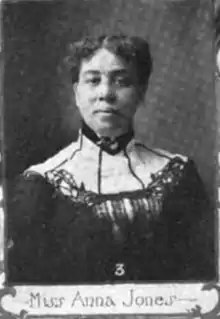Anna H. Jones
Anna H. Jones (1855 – 1932) was a Canadian-born American clubwoman, suffragist, and educator based in later life in Kansas City, Missouri.
Anna H. Jones | |
|---|---|
 Anna H. Jones in a 1902 publication | |
| Born | 1855 Chatham, Ontario |
| Died | 1932 (aged 76–77) Monrovia, California |
| Nationality | Canadian American |
| Alma mater | Oberlin College |
| Occupation | Educator, Suffragist |
Early life
Anna H. Jones was born in Chatham, Ontario, the daughter of Emily Francis Jones and James Monroe Jones.[1] Her father was one of the first black graduates of Oberlin College, finishing in 1849.[2] Her father was a gunsmith and engraver who, with his brother Elias Toussaint Jones, was involved with John Brown's Canadian abolition activities.[3][2] Anna H. Jones attended university in Michigan,[4] and graduated from Oberlin College in 1875.[5]
Her sister Sophia Bethena Jones (1857–1932) became a medical doctor, and "the first black faculty member at Spelman College" and founder of the school's nursing program.[6] Her sister Fredericka Florence Jones (1860-–) also became a teacher.[7]
Career
Anna H. Jones taught elocution at Wilberforce University in Ohio from 1885 to 1892. She taught high school and was a school principal in Kansas City, Missouri,[4] until 1916, when she retired from classroom work.
She was president of the Missouri Association of Colored Women's Clubs from 1903 to 1906. She raised the money to build a YMCA in Kansas City.[8] She represented the Kansas City Colored Women's League in the talks that resulted in the creation of the National Association of Colored Women's Clubs.[9] She wrote three biographical sketches for Hallie Q. Brown's Homespun Heroines and Other Women of Distinction (1926).[10]
Jones traveled to London in 1900 for the First Pan-African Conference, in the company of Anna Julia Cooper, Fannie Barrier Williams, and Ella D. Barrier, among others. Jones and Cooper were the only two African-American women to address the Conference;[11] Jones presented a paper titled "The Preservation of Race Individuality."[12] She later corresponded with W. E. B. DuBois.[13] In 1905 her two-part essay, "A Century's Progress for the American Colored Woman," appeared in consecutive issues of Voice of the Negro magazine.[14] Her short essay, "Women Suffrage and Social Reform" appeared in a 1915 issue of The Crisis.[15]
Katherine D. Tillman wrote a poem about Jones, titled "My Queen."[16]
Personal life
Jones moved to Monrovia, California, in 1921. She died there in 1932, aged 77 years. The Anna H. Jones Colored Women’s Club was organized in Monrovia in 1932, in her memory.[17]
References
- Gwen Robinson, "Grandfather Arrived in North Carolina Aboard Slave Ship" Archived 2017-03-02 at the Wayback Machine, Chatham Daily News (February 25, 2017).
- Steven Lubet, The "Colored Hero" of Harper's Ferry: John Anthony Copeland and the War against Slavery (Cambridge University Press 2015): 38, 102. ISBN 9781316352205
- Jacqueline L. Tobin, From Midnight to Dawn: The Last Tracks of the Underground Railroad (Doubleday 2007): 50. ISBN 9780385514316
- "A Shame", Washington Bee (October 27, 1894): 2. via Newspapers.com

- Roland M. Baumann, Constructing Black Education at Oberlin College: A Documentary History (Ohio University Press 2014). ISBN 9780821443637
- "Sophia B. Jones Charts a Course of Success for African-American Doctors", Our Stories Spelman College (April 2016).
- "An Appreciation" Rising Son (March 17, 1905): 5. via Newspapers.com

- "$4,000 More Needed to Furnish Y. M. C. A." Kansas City Sun (October 10, 1914): 1. via Newspapers.com

- Charles Edward Coulter, Take Up the Black Man's Burden: Kansas City's African American Communities, 1865–1939 (University of Missouri Press 2006): 39-41. ISBN 9780826265180
- Hallie Q. Brown, Homespun Heroines and Other Women of Distinction (Aldine Publishing, 1926): contents.
- Paul Finkelman, Encyclopedia of African American History, 1896 to the Present (Oxford University Press 2009): 246. ISBN 9780195167795
- Vivian M. May, Anna Julia Cooper, Visionary Black Feminist: A Critical Introduction (Routledge 2012): 23–28. ISBN 9781135911553
- Letter from Anna H. Jones to W. E. B. Du Bois, December 18, 1911, W. E. B. DuBois Papers, University of Massachusetts.
- Anna H. Jones, "A Century's Progress for the American Colored Woman," Voice of the Negro (September 1905): 631-633 and (October 1905): 692–694.
- Dawn Keetley and John Pettegrew, eds, Public Women, Public Words: A Documentary History of American Feminism: 1900 To 1960 (Rowman & Littlefield, 2005): 194–195. ISBN 9780742522251
- Claudia Tate, ed., The Works of Katherine Davis Chapman Tillman (Oxford University Press 1991): 35. ISBN 9780195062007
- Susie Ling, "Community Life South Of the Tracks: Blacks in Monrovia’s History" Monrovia Weekly (February 4, 2015).
External links
- A photograph of Anna H. Jones in later life, from the Oberlin University Archives.